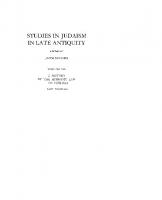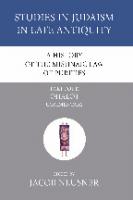The Theodosian Code: Studies in the Imperial Law of Late Antiquity 9781472540997, 9781853997402
The Theodosian Code, put together under the Eastern Roman Emperor Theodosius II, is a compliation of the laws dating fro
234 38 52MB
English Pages [260] Year 1993
Recommend Papers

- Author / Uploaded
- Jill Harries
- Ian Wood (editors)
File loading please wait...
Citation preview
Corrections.qxd
02/08/2010
10:55
Page vii
Preface to the Second Edition When this book first appeared in 1993, we were agreed that the contents were ‘not the last word on the compilation of the Code’ (p. 18) – or indeed on any other Code-related question. Subsequent scholarly activity has proved us right. The text is receiving fresh attention in its own right, through the Projet Volterra, based at University College London; and an ongoing French project aims to publish a French translation, based on Mommsen’s text, and commentary in a series of volumes, under the overall editorship of S. Crogiez-Petrequin and P. Jaillet. The essays contained in this volume address questions of fundamental importance as to what the code was, what it says about the nature of late Roman law and its impact on mediaeval Europe and beyond. A number of significant publications since, many by contributors to this volume, have improved understanding and stimulated further debate, both on the text itself (discussed in Part 1), its use as evidence for the history of Late Antiquity and its later place in the history of law. On the origins of the Code, John Matthews1 and Boudewijn Sirks2 still adhere, in general terms, to the positions outlined in their contributions to this volume on the archival and other sources for the constitutions, which the compilers would abbreviate and rearrange in (supposedly) chronological order. The Matthews study is especially wide-ranging: although much space is devoted to more technical matters, such as the sources, editing and what to do about the seriously incomplete state of Mommsen’s text (1905), he also captures the ‘historical moment’, when the Theodosian Code came into being (pp. 1-9), offers insights on numerous individual constitutions and (pp. 121-67) develops ideas on the Sirmondian Constitutions also addressed by Mark Vessey in this volume (below, 178-99). Since then, the Gesta Senatus have received detailed treatment from Lorena Alzeri,3 who, inter alia, suggests that the Senate meeting at Rome, where the Theodosian Code was presented by the prefect Anicius 1
Laying Down the Law: A Study of the Theodosian Code (Yale 2000). The Theodosian Code: A Study (Amsterdam 2007, revised 2008). 3 Gesta Senatus Romani de Theodosiano Publicando: Il codice Teodosiano e la sua diffusione ufficiale in Occidente (Berlin 2008). 2
vii
Corrections.qxd
viii
02/08/2010
10:55
Page viii
Preface to the Second Edition
Acilius Glabrio Faustus, took place, not on 25 December, but 25 May (amending VIII. K. Ian. to VIII.k. Iun.). An aspect perhaps underplayed in the present volume is the importance of adducing the Code of Justinian, not merely to plug gaps, as Krueger’s edition sought to do, but also to provide a setting for the Theodosian compilation in the broader framework of the Roman legal tradition. Tony Honoré’s contribution to this volume is one in a line of articles and books, notably his study of the quaestors of the Theodosian dynasty,4 which bring to life the draftsmen of the texts, the ‘mouths’ of the emperor. By identifying divergences in style and legal agendas, Honoré supplements what is known already of careerists at the imperial court, who held the office, while adding, on the basis of style, several more ‘anonymous’ individuals, who also contributed their learning and eloquence to imperial legislation. Thanks to him, the central position of the quaestor in the legislative process is increasingly accepted as a given, although some, like one of the present editors, might quibble that some of the shorter-lived ‘quaestors’ identified by Honoré may in face have been magistri memoriae, deputising while there was a vacancy. Increased understanding of how the texts came into being has rightly affected their use as sources by historians of Late Antiquity. For imperial constitutions were not dreamed up by emperors in isolation. They were the product of a process of dialogue and negotiation between emperors, officials and subjects. They reflect, in varying degrees, imperial preferences (even when edited, Julian the Apostate is allowed to refer to the temples and the gods in the plural); juristic tradition; and the self-interested suggestions or proposals of ambitious courtiers, provincial power-brokers and pressure-groups – even bishops. The situations on the ground, which generated the constitutions, and which were in turn affected by what the emperor decided, had their own dynamic; enforcement (e.g. of tax legislation or the criminal law) was only a small part of the emperor’s legislative role.5 Much of the ius civile, the law as it applied to Roman citizens, concerned dispute settlement; what emperors were asked to decide related, still, to problems faced by judges dealing with civil litigation in the courts. Much work remains to be done on the implications of the responsive character of imperial legislation. A decision which appears, in isolation, to be radical, such as Constantine’s ruling on one aspect of 4 Law in the Crisis of Empire, 399-455 AD (Oxford 1999). His study of Tribonian (London 1978) is definitive for the most influential of all quaestors, the man behind the Corpus Iuris Civilis of Justinian. 5 J. Harries, Law and Empire in Late Antiquity (Cambridge 1999). For the collective contribution of Harries (1999), Honoré (1999) and Matthews (2000), see A.D. Lee, ‘DeCoding Late Roman Law’, Journal of Roman Studies 92 (2002), 185-93.
Corrections.qxd
02/08/2010
10:55
Page ix
Preface to the Second Edition
ix
episcopal legal hearings (CT 1.27.1), becomes less so, once it is appreciated that the decision was a response to a question about an existing situation. In other words, Constantine did not found or legalise bishops’ judicial hearings; he merely offered assistance when problems arose. The same applies to his decisions on manumission in churches, and whether this could be done on a Sunday. Constantine did not institute manumission before bishops, nor did he make Sunday a holiday; he merely answered questions about regulations and how the holiday should be observed. The work of Caroline Humfress has analysed the importance of the responsive and negotiated nature of imperial law in relation to Christianity, heresy and court procedure;6 she is also a leading analyst of the place of imperial law in the juristic tradition. The importance of the courts and of church councils in the formation of questions, referrals, proposals and decisions is becoming increasingly clear. Fergus Millar’s work on the ‘legislative’ processes of the Church Councils under Theodosius II shows in detail the working of proposal and response as a means of ‘persuading’ (and being persuaded by) the powerful elite at the court of Constantinople.7 The presence of the proposer, the consistorium, which debated legal decisions, the quaestor who drafted them and emperors, who might have views of their own, complicates the issue of authorship; we cannot be sure whose views a given text in fact reflects (although, formally, they are those of the emperor). The Theodosian Code, therefore, is not a single text but an anthology of texts, reflecting divergent agendas and providing a snapshot of only one stage in the negotiated process of producing a ‘law’. The missing voices should be acknowledged, even if we cannot identify them for sure. Nor can we be sure of the scale of the problems addressed. Large numbers of entries on a topic indicate, not that the problem was necessarily widespread, but that it was in the interest of a lot of people that the imperial line on it should be known. Still, the Code reflects the endproduct of imperial decision-making and, working on that basis, two recent collections of essays on Late Antiquity drawing on the Theodosian Code as a ‘source’ provide diverse examples of how the Theodosian Code can be used to illuminate the history of late antiquity.8 As for the afterlife of the Code, that too has been the subject of 6
Orthodoxy and the Courts in Late Antiquity (Oxford 2007). F. Millar, A Greek Roman Empire: Power and Belief under Theodosius II (408-450) (Berkeley, California 2006). 8 S. Crogiez-Petrequin and P. Jaillet, with O. Huck (edd.), Le Code théodosien: diversité d’approches et nouvelles perspectives (École française de Rome 2009) is issued in conjunction with the French translation project. See also J.-J. Aubert and P. Blanchard (edd.), Droit, Religion et Société dans le Code Théodosien (Geneva 2009). 7
Corrections.qxd
x
02/08/2010
10:55
Page x
Preface to the Second Edition
increased interest. In particular the 1500th anniversary of the promulgation of the Breviary of Alaric prompted reconsideration of the breviary itself, of its relations with the Code, and of its manuscript history – which, given the textual problems of the Code, itself casts light on the Theodosian compilation.9
9 M. Rouche and B. Dumézil (edd.), Le Bréviare d’Alaric. Aux origines du Code civil (Paris 2008).









